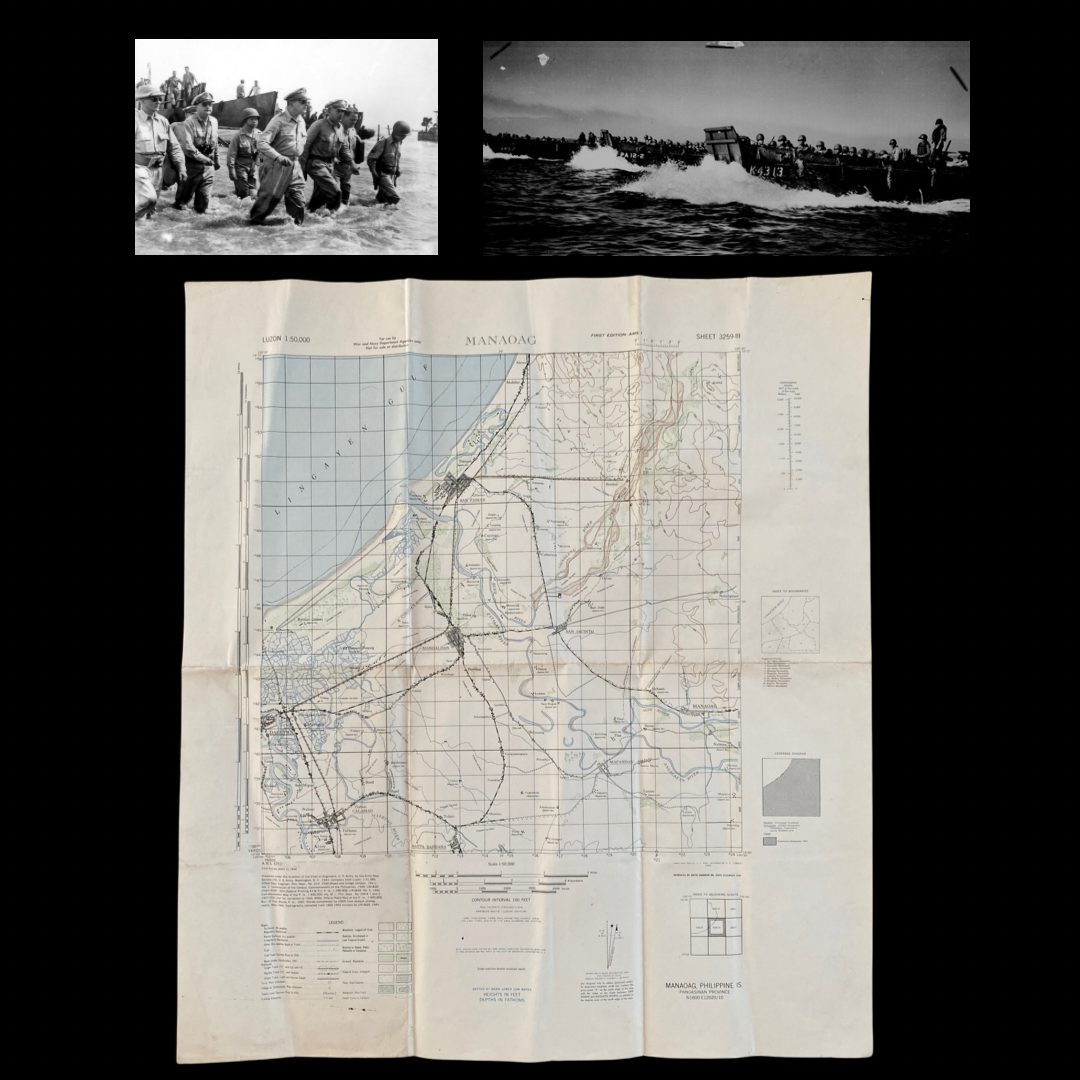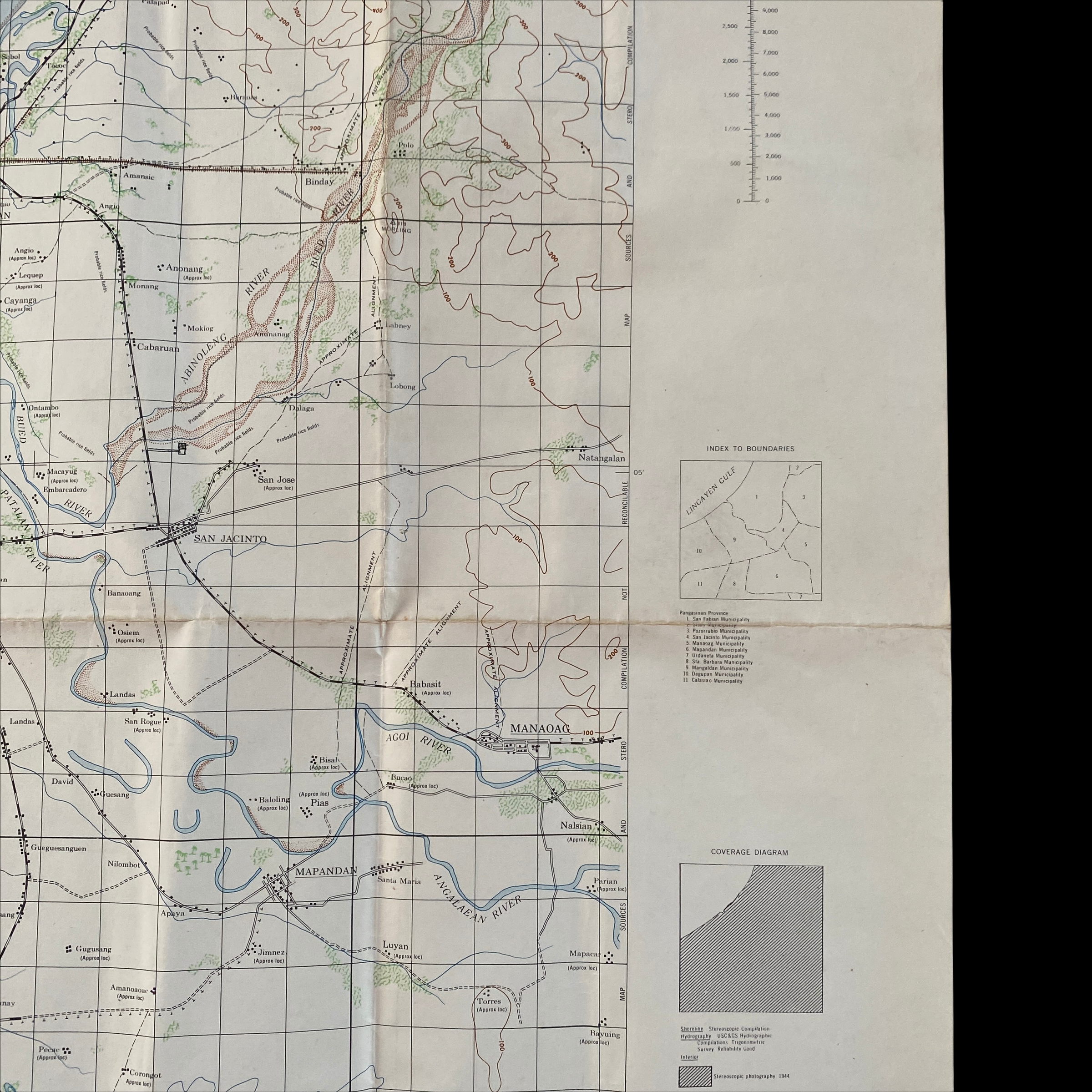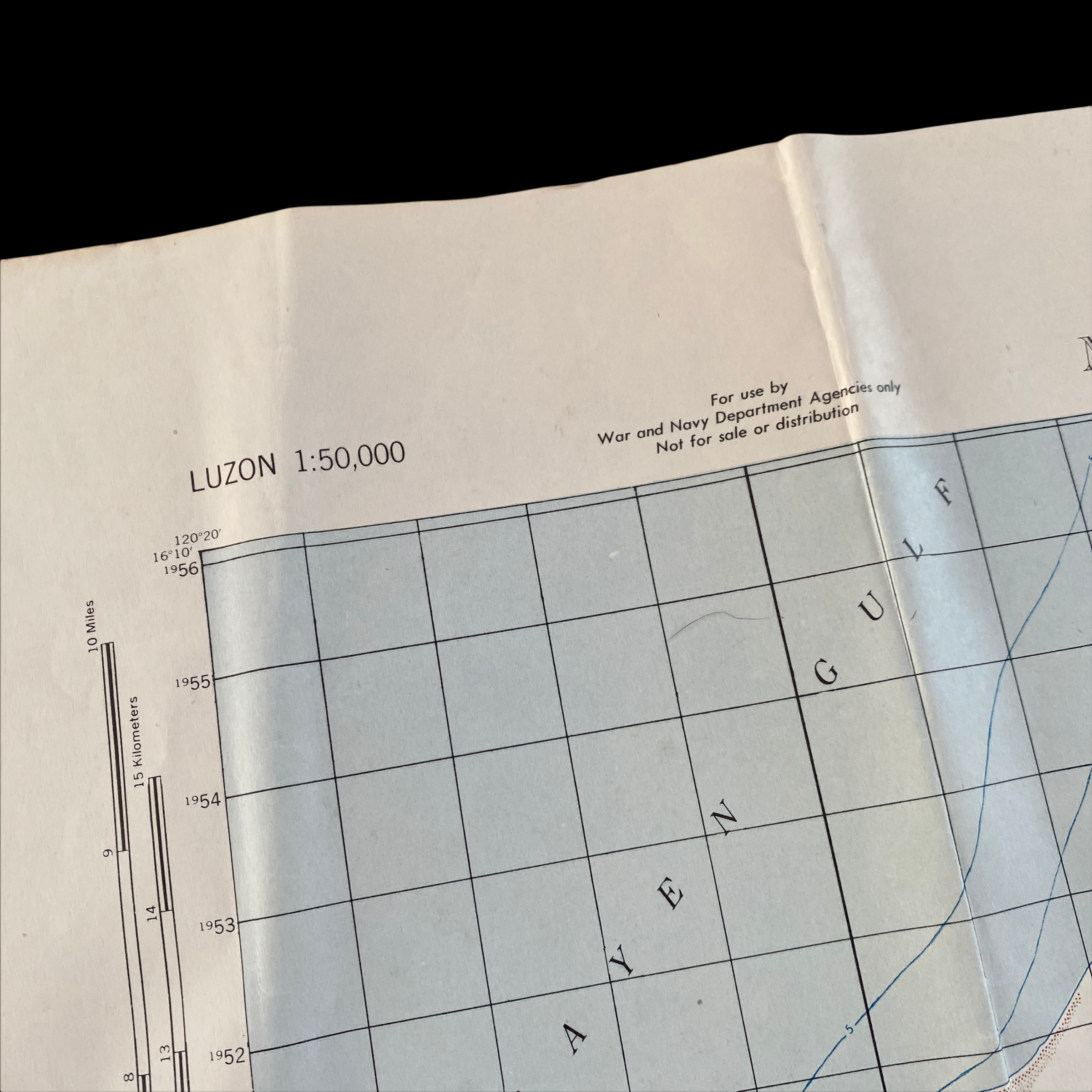WWII D-Day WHITE and BLUE Beach Infantry Assault Map Lingayen Gulf (MacArthur Return to Philippines)


























WWII D-Day WHITE and BLUE Beach Infantry Assault Map Lingayen Gulf (MacArthur Return to Philippines)
Comes with C.O.A.
This incredibly rare WWII amphibious assault map was used in the Invasion of Lingayen Gulf, also known as the Invasion of Luzon and “MacArthur’s Return to the Philippines”. Titled “Manaoag” shows the amphibious beachhead assault of Lingayen Gulf encompassing the D-Day landing beaches of WHITE 1 (172nd Infantry), WHITE 2 (169th Infantry), WHITE 3 (103rd Infantry), BLUE 1 (1st Infantry), and BLUE 2 (20th Infantry). Just five hours after the first wave assault on the beach MacArthur waded ashore, thus creating one of his most memorable photographs of WWII and his promised return to Luzon and the Philippines.
A lack of charts had handicapped war planners, forcing them to consult a 1903 U.S. Coast and Geodetic Survey report to determine beach gradients. To supplement that dated information, hydrographic ships had taken depth readings and marked shoals that might strand landing craft, while reconnaissance flights snapped more than 18,000 photos. U.S. warships meanwhile pounded the beaches, firing a staggering 16,795 armor-piercing and high-capacity rounds. Navy fighters and bombers joined the fight, flying 788 sorties, aided by guerrilla fighters’ drawings of nearby arms and fuel depots. Gone now were any coastal defense guns, pillboxes, or even buildings that might offer mortar teams or snipers a place to hide.
The objects of the campaign were as follows:
1. To penetrate and pierce the enemy's center so as to divide him into north and south, his homeland to the north, his captured Pacific possessions to the south. Each half could then be enveloped and attacked in turn.
2. The acquisition of a great land, sea and air base for future operations both to the north and to the south comparable to the British Islands in its use as a base for allied operations from the west against Germany.
3. The establishment of a great strangulating air and sea blockade between Japan and the conquered possessions in the Pacific to the south so as to prevent raw materials from being sent to the north and supply or reinforcement to the south.
4. The Liberation of the Philippines with the consequent collapse of the enemy's imperial concept of a Greater East Asia Co-Prosperity Sphere and the reintroduction of democracy in the Far East.
5. The liberation of our captured officers and men and of internees held in the Philippines.
6. A crippling blow to the Japanese Army, Navy, and Air force.
The invasion of Luzon, the main island of the Philippines, was set for 9 January 1945, with preliminary minesweeping and bombardment operations by the U.S. Navy to commence on 6 January. The plan called for 68,000 U.S. troops of the Sixth Army to be put ashore on the first day at the southern end of Lingayen Gulf (with over 200,000 troops to be ashore within several days) all under the overall command of General of the Army Douglas MacArthur. The landing beaches at Lingayen are about 110 miles north northwest of the Philippine capital of Manila, MacArthur’s primary objective. Although there were a couple other possible landing areas and avenues of approach to Manila, Lingayen was the best from an Army ground perspective (and was also where the Japanese landed when they invaded the Philippines in December 1941).
General Douglas MacArthur was anxious in the predawn hours of 9 January 1945, as U.S. troops prepared to storm the beaches of the Philippine island of Luzon. Two years, nine months, and 29 days had passed since MacArthur had climbed aboard a patrol torpedo boat and slipped away under cover of darkness, forced to watch in despair as the silhouette of Corregidor vanished on the horizon. His fortunes since had changed dramatically. He had traded the worn-out PT boats that had spirited him, his family, and his aides to safety for an armada of 818 aircraft carriers, battleships, cruisers, destroyers, and transports—the largest invasion force the United States had ever put to sea in the Pacific.
Despite that power, the same tension that had marked MacArthur’s escape years earlier clouded his return. U.S. forces had seized the islands of Leyte and Mindoro, but the ultimate prize still eluded MacArthur—the main island of Luzon, home to Manila, the political and cultural heart of the Philippines.
To block MacArthur, Japan had unleashed its infernal new weapon, kamikazes—a monsoon of metal and flesh that rained down daily on U.S. forces. The threat from suicide planes had crystallized four days earlier when a twin-engine bomber crashed through the wooden flight deck of the escort carrier Ommaney Bay (CVE-79). “A tremendous explosion shook the ship so violently it seemed as if a gigantic pile driver had hit us,” recalled Chaplain Robert Anderson.
The carrier’s hangar deck, filled with racks of torpedoes and armed planes fueled to capacity, erupted in an inferno. Machine-gun rounds exploded, ricocheting off bulkheads. The skipper had no choice but to order his ship abandoned just 38 minutes after the attack. Survivors watched from the water as exploding torpedoes caused part of the flight deck to collapse, a horror captured in the ship’s war damage report: “Intensity of fire remained such as to insure [sic] that the ship was practically gutted in the next hour.”
The destruction of the Ommaney Bay foreshadowed MacArthur’s troubles. Two days later, Japanese planes tore into 15 ships, including the bridge of the 32,000-ton battlewagon New Mexico (BB-40). The fiery crash killed the skipper along with British Lieutenant-General Herbert Lumsden—Prime Minister Winston Churchill’s liaison—and Time magazine correspondent Bill Chickering, all of whom were later wrapped in canvas, weighted down with 5-inch projectiles, and buried at sea after sunset.
“The action was so fast and so continuous that it is hard to sort out the images of what happened,” Chickering had written to his wife only hours before his death. “They came in from all sides.”3 The ferocious kamikazes, which would ultimately injure or kill more than 2,100 sailors, sink two dozen ships, and damage another 67, signaled the strategic and symbolic importance of the coming invasion. This was far more than just the capture of another island in the United States’ push across the Pacific.
MacArthur was coming home.
“If the Lord will let me land this one,” the general had announced to his aides the morning before over breakfast, “I’ll never ask so much of [H]im again.